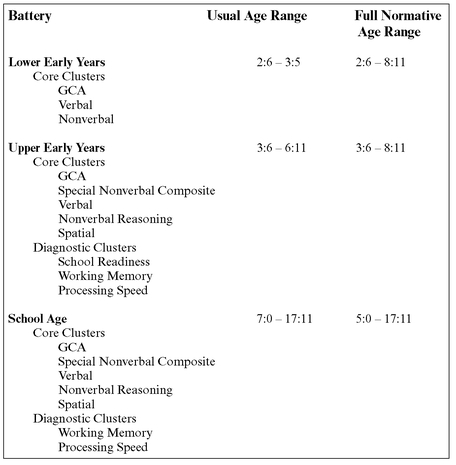Allison Decker’s Updates
Update 1: Differential Ability Scales-Second Edition
One type of assessment method that I researched was the Differential Ability Scales-Second Edition, or DAS-II. The developer of this test was Colin D. Elliot and it was derived directly from the British Avility Scales. The test is used to assess children from 2 years of ageto 17 years 11months. Because of the flexibility of the test, it can be used for children with varying levels of cognitive development. The test takes a holistic approach and utilizes a unique scoring method, which can be a bit more time-consuming, but yields more individual results based on the test subjects.
The DAS-II is comprised of 20-22 subtests that include Early Years and School-Age. From those levels there are core subtests of abilities. These tests look at both verbal and non-verbal capacities which will differ based on the age groups (Early Years vs. School-Age) to ensure appropriate criteria is being assessed.
Figure 1: Cluster by Battery DAS-II
According to the article, Differential Ability Scales-Second Edition by C.D. Elliott, "The DAS-II is formatted to provide three scoring schemes, including a global composite score, lower-level clusters, and individual specific-ability subtests" (Elliott p. 91). This may sound complex, but the guidelines and manuals are easy to comprehend and there are specifc templates used throughout the process.
One factor that seems appealing about this type of testing/assessment is that it eliminates a great deal of test bias. The abilities assessed in the DAS-II are directly related to age-specific educational needs. According to the article, Differential Ability Scales (DAS and DAS-II), by Celine Saulnier, "The DAS-II has strong internal reliability, with average reliability coefficients for the Early Years subtests ranging from .79 to .94 and for the School-Age subtests ranging from .74 to .96. The average reliability for the DAS-II GCA is .95 for Early Years and .96 for School Age" (Saulnier p. 38). When looking at assessment methods, it is important to ensure that it is valid and reliable. Because of the elimination of some common test bias and the strong reliability, it appears as though this assessment method is ideal. There are also both clinical and educational uses for the assessment when testing students' cognitive abilities. Results typically lead to educational accommodations and/or treatment options.
The DAS-II is also a recommended assessment method because of the various abilities that are measured/assessed. This differentiates the DAS-II from some other assessment methods because of the results yielded. It also encompasses a more diverse range of children/populations and can be given quickly in a way that is not overwhelming for the test subjects. C.D. Elliott states that, "Overall, the DAS-II may provide a user-friendly, time-efficient measure of general cognitive ability that proves useful in the context of a full psychoeducational battery of assessment measures" (Elliott p. 93).
I have attached a brochure from the Psychological Corporation for an additional reference on DAS-II.
References:
Elliott, Colin. Differential Ability Scales-Second Edition. San Antonio, TX: Harcourt Assessment, 2007.
Saulnier, C.A. (2013) Differntial Ability Scales (DAS and DAS II). In: Volkmar F.R. (eds) Encyclopedia of Autism Spectrum Disorders. Springer, New York, NY.
Elliott, Colin. DAS-II Batteries. The Psychological Corp., San Antonio, TX. 2007


